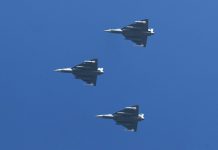US aerospace giant Boeing, which is selling six P-8I Neptune aircraft to the Indian Navy, has disclosed its offset commitment to 30% of the value of the sale.
On April 30, the US State Department’s Defense Security Cooperation Agency announced the sale of six P-8I Neptune Maritime Patrol Aircraft (and associated equipment) to the Indian Navy under the Foreign Military Sales for an estimated cost of $2.4 billion.
In recent revelations to Janes, Boeing officials told that about 30% of the cost would be allocated to offset obligations worth $730 million, that “will comprise direct and indirect offset activity in line with previous Indian government offset requirements.
The offset deal is thought to be linked to India’s original P-8I contract in 2009 when it procured eight aircraft through the Direct Commercial Sale (DCS) route.”
According to a Boeing spokesperson, “The offset requirement for India is 30% of the cost of acquisition and its fulfillment can be through various avenues (direct or indirect offsets) as outlined in India’s defense offset guidelines.”
Refusing to disclose the specifics of offset proposals, he said Boeing is “committed to delivering offset projects that are in line with India’s Defence Procurement Procedure and meet the Indian government’s stated goals, including strengthening India’s aerospace capabilities”.
This new deal would improvise the Indian Navy’s P-8I fleet to a total of 18 aircraft, which could be a major to its operational capabilities. The Indian Navy procured eight P-8I aircraft from Boeing in January 2009, via Direct Commercial Sale and contracted for an additional four aircraft in July 2016.
The first P-8I aircraft were delivered to the Indian Navy in 2013, providing interoperability and critical capabilities to coalition maritime operations.
The P-8I Neptune
An India-specific variant of the P-8A — P-8I ‘’Neptune’ — was proposed by Boeing to the Indian government. This export variant included two additions not featured in the USN’s P-8A, which are a Telephonics APS-143 OceanEye aft radar and a magnetic anomaly detector (MAD).
After analyzing Boeing’s proposal, the Indian Navy was impressed and the government signed a $2.1 billion agreement with the company for eight P-8Is to replace the Indian Navy’s aging Tupolev Tu-142M maritime surveillance turboprops. It was Boeing’s first international sale to India.
The indigenous Bharat Electronics Limited (BEL) Data Link II communications allow the P-8I to exchange tactical data between Indian Navy aircraft, ships, and shore establishments; it also features an integrated BEL-developed IFF system.
India has purchased AGM-84L Harpoon Block II missiles and Mk 54 All-Up-Round Lightweight torpedoes for the P-8I.
The P-8I is designed for long-range anti-submarine warfare, anti-surface warfare, and intelligence, surveillance, and reconnaissance missions. It has a range of about 2,200 km and flies at a maximum speed of 490 knots, or 789 km per hour.
The US has deployed the P-8s to track its adversaries – China and Russia. The P-8A Poseidon has mastered hunting Russian submarines. According to the Aviationist, in December 2016, Poseidon aircraft were engaged in hunting Oscar-class submarines in the Mediterranean.
Experts call the P-8As one of the strongest US assets for naval warfare against China and Russia.
A number of key systems on the P-8 are designed to track submerged submarines. A rotary launcher system in the rear of the P-8 can dispense sonar buoys into the water. A recent upgrade allows P-8s to employ new Multistatic Active Coherent buoys that generate multiple sonar pulses over time, allowing for greater endurance and search range.
The P-8 also has its own acoustic sensor and even a new hydrocarbon sensor that can “sniff” for fuel vapor from submarines. The Poseidon can carry five missiles, depth charges or torpedoes in a rotary launcher in the rear hull, and six more on underwing racks.
The P-8 can also use a special High Altitude Air Launch Accessory to transform its Mark 54 324-millimeter lightweight torpedoes into GPS-guided glide bombs that can be dropped from altitudes as high as 30,000 feet.
The purchase of six P-8I was cleared by the Defence Acquisition Council in November 2019, long before the stand-off with China along the Line of Actual Control in Ladakh.




